The Sturmabteilung was the original paramilitary wing of the Nazi Party. It played a significant role in Adolf Hitler's rise to power in the 1920s and early 1930s. Its primary purposes were providing protection for Nazi rallies and assemblies, disrupting the meetings of opposing parties, fighting against the paramilitary units of the opposing parties, especially the Roter Frontkämpferbund of the Communist Party of Germany (KPD) and the Reichsbanner Schwarz-Rot-Gold of the Social Democratic Party of Germany (SPD), and intimidating Romani, trade unionists, and especially Jews.

The uniforms and insignia of the Schutzstaffel (SS) served to distinguish its Nazi paramilitary ranks between 1925 and 1945 from the ranks of the Wehrmacht, the German state, and the Nazi Party.
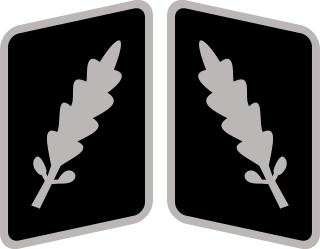
Standartenführer was a Nazi Party (NSDAP) paramilitary rank that was used in several NSDAP organizations, such as the SA, SS, NSKK and the NSFK. First founded as a title in 1925, in 1928 it became one of the first commissioned NSDAP ranks and was bestowed upon those SA and SS officers who commanded a unit known as a Standarte, a unit equivalent to an army battalion and comprising 300–500 personnel.
Fascist symbolism is the use of certain images and symbols which are designed to represent aspects of fascism. These include national symbols of historical importance, goals, and political policies. The best-known are the fasces, which was the original symbol of fascism, and the swastika of Nazism.

Kurt Max Franz Daluege was a German SS and police official who served as chief of Ordnungspolizei of Nazi Germany from 1936 to 1943, as well as the Deputy/Acting Protector of Bohemia and Moravia from 1942 to 1943.
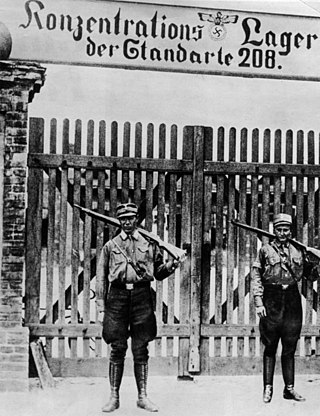
The uniforms and insignia of the Sturmabteilung (SA) were Nazi Party paramilitary ranks and uniforms used by SA stormtroopers from 1921 until the fall of Nazi Germany in 1945. The titles and phrases used by the SA were the basis for paramilitary titles used by several other Nazi paramilitary groups, among them the Schutzstaffel (SS). Early SS ranks were identical to the SA, since the SS was originally considered a sub-organisation of the Sturmabteilung.

Julius Schreck was an early senior Nazi official and close confidant of Adolf Hitler.
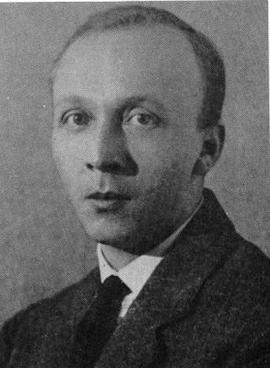
Erhard Heiden was an early member of the Nazi Party and the third commander of the Schutzstaffel (SS), the paramilitary wing of the Sturmabteilung. He was appointed head of the SS, an elite subsection of the SA in 1927. At that time the SS numbered fewer than a thousand men and Heiden found it difficult to cope under the much larger SA. Heiden was not a success in the post, and SS membership dropped significantly under his leadership. He was dismissed from his post in 1929, officially for "family reasons". He was arrested after the Nazis came to power in 1933 and executed that same year.

Hugo Ferdinand Boss was a German businessman and an early member of the Nazi Party. He was the founder of the fashion house Hugo Boss AG.

Obersturmführer was a Nazi Germany paramilitary rank that was used in several Nazi organisations, such as the SA, SS, NSKK and the NSFK.

Karl August Hanke was an official of the Nazi Party (NSDAP) during its rule over Germany who served as the fifth and final Reichsführer of the Schutzstaffel (SS). He also served as Gauleiter of Gau Lower Silesia from 1941 to 1945 and as Oberpräsident of the Prussian Province of Lower Silesia. Captured on 6 May 1945, he was shot and wounded during an escape attempt and then beaten to death by Czech guards on 8 June, after the war had ended.
Wolfsangel or Crampon is a heraldic charge from mainly Germany and eastern France, which was inspired by medieval European wolf traps that consisted of a Z-shaped metal hook that was hung by a chain from a crescent-shaped metal bar. The stylized symbol of the Z-shape can include a central horizontal bar to give a Ƶ-symbol, which can be reversed and/or rotated; it is sometimes mistaken as being an ancient rune due to its similarity to the "gibor rune" of the pseudo Armanen runes.

Ranks and insignia were used by the National Socialist German Workers' Party (NSDAP) as paramilitary titles between approximately 1928 and the fall of Nazi Germany in 1945. Such ranks were held within the political leadership corps of the Nazi Party, charged with the overseeing of the regular Nazi Party members.

The Black Sun is a type of sun wheel symbol originating in Nazi Germany and later employed by neo-Nazis and other far-right individuals and groups. The symbol's design consists of twelve radial sig runes, similar to the symbols employed by the SS in their logo. It first appeared in Nazi Germany as a design element in a castle at Wewelsburg remodeled and expanded by the head of the SS, Heinrich Himmler, which he intended to be a center for the SS.

Hitler's SS: Portrait in Evil is a 1985 American made-for-television war drama film about two German brothers, Helmut and Karl Hoffmann, and the paths they take during the Nazi regime. The movie was directed by Jim Goddard and starred John Shea, Bill Nighy, Tony Randall, David Warner and John Woodnutt. The film shows Karl, who was originally enthusiastic about the Nazi Party, becoming disillusioned and Helmut, who was at first wary of the Nazi Party, joining the Schutzstaffel (SS) and later being an accomplice to war crimes.
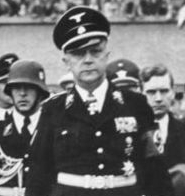
Friedrich Karl Freiherr von Eberstein was a member of the German nobility, early member of the Nazi Party, the SA, and the SS. He was elected to the Reichstag and held the position of the chief of the Munich Police during the Nazi era. Eberstein was a witness at the Nuremberg Trials.

Bruno Gesche rose to the rank of Obersturmbannführer in the SS in Nazi Germany. He was a member of Adolf Hitler's entourage and the fourth commander of Hitler's personal bodyguard for the periods June 1934 – April 1942 and December 1942 – December 1944.

Hans Helwig was a German Nazi Party politician, World War I veteran, Schutzstaffel general and Nazi concentration camp commandant. An early member of the Nazi movement he fulfilled a number of roles within Nazism down the years. He was born and died in Hemsbach.
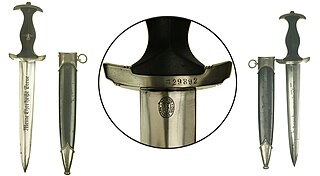
The SS-Ehrendolch was considered an honour weapon of the Schutzstaffel (SS). In addition to this dagger there was also the SS Honour Ring and SS Honour Sword. The awarding ceremony was conducted according to strict rules developed by Heinrich Himmler.
The SS Education Office (SS-Schulungsamt) was one of the Nazi organizations responsible for the ideological indoctrination of members of the SS. The office operated initially under the jurisdiction of the Reich Race and Settlement Office (RuSHA) but was later subordinated to the SS Main Office (SS-Hauptamt).


















